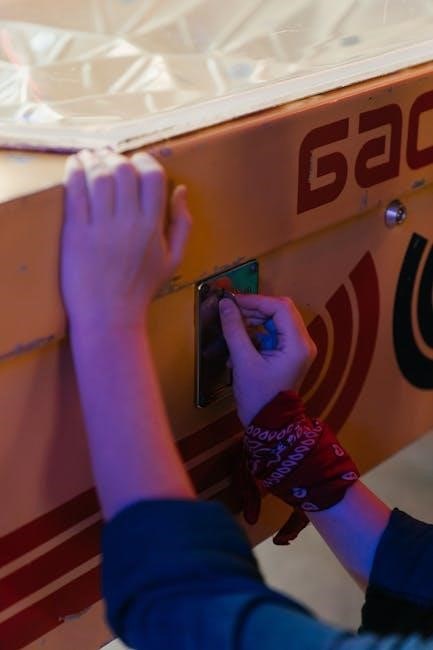
kitchenaid ice machine manual
Welcome to the KitchenAid Ice Machine Manual. This guide provides essential information for installing, using, and maintaining your ice maker. Refer to it for troubleshooting and optimal performance tips.
Overview of the Manual’s Purpose and Structure
This manual is designed to help you understand and make the most of your KitchenAid ice machine. It serves as a comprehensive guide for installation, operation, care, and troubleshooting. The manual is divided into clear sections, each addressing specific aspects of the ice maker, such as setup requirements, daily usage, maintenance routines, and resolving common issues. Detailed instructions and tips are provided to ensure optimal performance and longevity of the appliance. Additionally, it includes error codes and solutions to help you diagnose and fix problems independently. By following the guidelines and recommendations outlined in this manual, you can enjoy efficient ice production and extend the lifespan of your KitchenAid ice machine.

Installation Instructions

Proper installation ensures your KitchenAid ice machine operates efficiently. Follow guidelines for location, electrical connections, and water supply. Ensure the unit is level and securely installed for optimal performance.
Location Requirements for Optimal Performance
Selecting the right location for your KitchenAid ice machine is crucial for efficient operation. Ensure the unit is installed in a well-ventilated area, away from direct sunlight and heat sources like ovens or dishwashers. The ideal location should maintain a temperature between 32°F and 100°F (0°C and 38°C) to prevent overheating. Additionally, place the ice maker on a level surface to ensure proper water flow and ice production. Avoid installing it near corrosive substances or in areas prone to moisture, as this may damage the machine. Proper placement will help maintain performance, durability, and energy efficiency. Always follow the manufacturer’s guidelines for specific installation requirements.
Electrical and Water Supply Requirements
Your KitchenAid ice machine requires a dedicated 115-volt, 60 Hz electrical outlet to operate safely and efficiently. Avoid using extension cords or shared circuits, as this may cause power fluctuations. For water supply, connect the machine to a cold water line using 1/4-inch OD soft copper tubing or a Whirlpool supply line. Ensure the water pressure is between 20 and 100 PSI for optimal performance. A shutoff valve is recommended to control water flow during maintenance or repairs. Proper electrical and water connections are essential to prevent damage and ensure reliable ice production. Always refer to the manual for specific requirements and follow local plumbing and electrical codes for a safe installation.

Using the Ice Maker
Learn how to operate your KitchenAid ice machine, including control functions, monitoring ice levels, and managing production. Understanding normal sounds and cycles ensures efficient ice-making performance.
Operating the Controls and Understanding Normal Sounds
Your KitchenAid ice maker features intuitive controls, including buttons for starting/stopping operation, delaying ice production, and initiating cleaning cycles. The display provides status updates and error codes. During operation, you may hear normal sounds such as water filling, ice dropping into the bin, and the compressor or fan running. These noises indicate proper function. Ensure you familiarize yourself with these sounds to distinguish them from unusual noises that may signal issues. Always refer to the manual for guidance on using the controls and troubleshooting unexpected sounds or behaviors.
Monitoring Ice Levels and Managing Production
The KitchenAid ice maker is equipped with an ice level sensor that monitors the amount of ice in the storage bin. When the bin is full, the sensor automatically stops ice production to prevent overflow. If you remove ice, production resumes once the sensor detects space. Use the manual controls to pause or restart ice production as needed. Some models feature an energy-saving mode that reduces production frequency during periods of low demand. Regularly check the ice level to ensure optimal performance and avoid overfilling. For high-demand situations, ensure the bin is at least 50% empty before peak usage. Proper monitoring helps maintain efficiency and prevents potential issues with ice production. Always refer to the manual for specific guidance on managing your model’s ice-making settings.

Care and Maintenance
Regularly clean the ice maker and storage bin to ensure hygiene. Defrost as needed and check water filters. Proper maintenance ensures efficient ice production and longevity.
Cleaning the Ice Maker and Storage Bin

Regular cleaning is essential for maintaining your KitchenAid ice maker’s performance and hygiene. Turn off the ice maker and allow it to defrost completely. Mix a solution of water and vinegar to wipe down the interior and remove mineral buildup. Use a soft cloth to clean the exterior and avoid abrasive materials that may damage the finish. The ice storage bin should be emptied and washed with mild soap and warm water. Rinse thoroughly and dry before refilling. For tougher stains or odors, a mixture of equal parts water and white vinegar can be effective. Always refer to your manual for specific cleaning recommendations to ensure optimal function and longevity.
Defrosting and Routine Maintenance Tips
Regular defrosting and maintenance are crucial for your KitchenAid ice maker’s efficiency. Defrost the unit every 6 months or when ice buildup exceeds 1/4 inch. Turn off the power, allow it to thaw naturally, and wipe down surfaces with a mixture of water and vinegar. For routine maintenance, clean the condenser coils annually to ensure proper airflow and performance. Check and replace the water filter every 6 months to prevent mineral buildup and maintain water quality. Inspect the drain tube regularly to ensure it’s free of blockages. Lubricate moving parts like the ice scoop hinge if necessary. Always refer to your manual for specific maintenance schedules and guidelines to keep your ice maker functioning optimally and extend its lifespan.

Troubleshooting Common Issues
Identify and resolve common problems with your KitchenAid ice maker. Check for issues like uneven ice production, strange noises, or water leaks. Refer to error codes in your manual for specific solutions and follow the recommended steps to restore functionality. Regular maintenance and proper installation can prevent many issues. Always consult the troubleshooting guide before contacting professional support for assistance.
Identifying and Resolving Common Problems
Common issues with your KitchenAid ice maker may include ice production problems, unusual noises, or water leaks. Start by checking the water supply and drain tube for blockages or kinks. Ensure the ice maker is properly installed and leveled. If the machine is not producing ice, verify that the water supply is turned on and the ice maker switch is activated. For error codes, refer to your manual for specific solutions. Clean the machine regularly to prevent mineral buildup. If issues persist, reset the ice maker by turning it off and on again. Always consult the troubleshooting guide before contacting customer support for further assistance.
Understanding Error Codes and Solutions
Your KitchenAid ice maker may display error codes to indicate specific issues. These codes, such as “E1” or “E2,” are designed to help diagnose problems quickly. Refer to your manual for a complete list of codes and their meanings. Common issues include sensor malfunctions, water supply problems, or temperature discrepancies. For example, an “E1” error may indicate a faulty ice level sensor, while “E2” could signal a temperature control issue. To resolve these, ensure the water supply is functioning, check for blockages, and verify proper installation. Clean sensors and reset the machine if necessary. If errors persist, consult the troubleshooting guide or contact KitchenAid customer support for professional assistance. Always follow the manual’s instructions for accurate solutions.